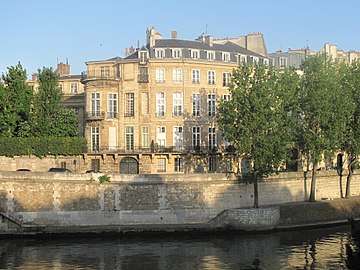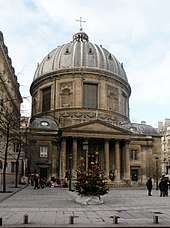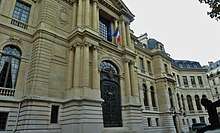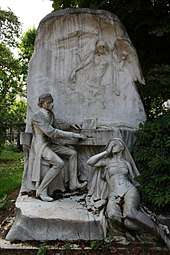Poles in France
Poles in France form one of the largest Polish diaspora communities in Europe. About one million people of Polish descent live in France, concentrated in the Nord-Pas de Calais region, in the metropolitan area of Lille, the coal-mining basin (Bassin Minier) around Lens and Valenciennes and in the Ile-de-France.
| Total population | |
|---|---|
| 1,000,000 (2009) [1] 2% of the French population | |
| Regions with significant populations | |
| Île-de-France, Nord-Pas-de-Calais, Alsace, Lorraine, Centre-Val de Loire... | |
| Languages | |
| Polish, French | |
| Religion | |
| Christianity, Atheism, Irreligion, Judaism | |
| Related ethnic groups | |
| Poles, French, Silesians |
Prominent members of the Polish community in France have included Frédéric Chopin, Adam Mickiewicz, Adam Jerzy Czartoryski, Aleksander Chodźko, Marie Curie, Michel Poniatowski, Raymond Kopa, Ludovic Obraniak, Edward Gierek (who was raised there), Matt Pokora and singer Jean-Jacques Goldman and Rene Goscinny.
History

Polish-Lithuanian Commonwealth
Close ties between the Kingdom of France and Polish–Lithuanian Commonwealth were cemented in the 16th century, when emissaries from Poland persuaded French Prince Henri de Valois to stand for election as King of the Commonwealth. Valois won and reigned for two years in Poland but abdicated after he inherited the French throne as Henri III. The queen consort of Louis XV and grandmother of several of his successors was Marie Leszczyńska (1703-1768).
French Revolution and Napoleonic wars
Many members of the Polish Szlachta fled to France during the rule of Napoleon when 100,000 Poles tried to throw off Russian rule in Poland early in the 19th century. Many had enlisted to fight in the Grande Armée, like Józef Antoni Poniatowski, Ludwik Mateusz Dembowski Polish commanders of the Napoleonic Wars and Polish legionnaires.
Great Emigration (1831-1870)


The so-called Great Emigration was the flood of exiles in the aftermath of the 1831 November Uprising, made up of political elites mainly from the Russian Partition of Poland between 1831–1870 who settled in France.

Interwar period
Another wave of Polish migration, this time in search of manual work, took place between the two World Wars, when they were hired as contract workers to work temporarily in France. After the outbreak of World War II Polish refugees also fled Nazi or Soviet occupation.
Polish resistance during the Nazi occupation in France
During the Nazi occupation of Poland, a specific Polish Resistance group, Polska Organizacja Walki o Niepodleglosc – Organisation Polonaise de Lutte pour l’Indépendance (POWN), was created on September 6, 1941 by the Polish general consul in Paris, A. Kawalkowski (code name Justyn), and fought alongside the French Resistance. There were also other Polish Resistance movements in France, most notably former soldiers from the Jaroslaw Dabrowski Brigade who had fought in the International Brigades during the Spanish Civil War went on in their struggle against Fascism in the FTP-MOI. Since 1941 PPS activists in Northern France had also founded two resistance movements, Organisation S and Orzel Bialy (White Eagle). In 1944 Polish Committees for National Liberation (PKWN) were set up to support the Communist Polish army. There were clashes between POWN resistants, under the authority of the London-based Polish government in exile, and the Communist FTP-MOI resistants.[2]
French Poles after WWII
When the Communists took power in Poland, several thousand French Poles decided to go and live in the "Socialist paradise", as some Armenians in France moved to the Armenian Soviet Socialist Republic.
There are estimates of 100,000 to 200,000 Poles living in Paris, and many EU program guest workers live in regions of the south, including Arles, Marseille and Perpignan.
From the year 2012
The number of new Poles who migrated to France has multiplied, many are students and traders and other percentage are displaced workers who come from Poland to work in France. Poles are well integrated into French society. The number of new Polish citizens in France amounts to 350,000 in 2012.[3]
Notable Polish French people
18th century
- Stanisław Leszczyński (1677-1766) King of Poland, Duke of Lorraine
- Maria Leszczyńska (1703-1768) Polish Princess, queen consort of France
First half of the 19th century

- Frédéric Chopin (1810-1849) pianist and composer.
- Samuel Rosenthal (1837-1902) chess player.
- Marie Walewska (1786-1817) noblewoman and mistress of Napoleon I.
Second half of the 19th century
- Count Xavier Branicki (1816-1879) magnate, financial and philanthropist.
- Marie Curie (1867-1934) physicist.
- Joseph Babinski (1857-1932) doctor.
- André Citroën (1878-1935) founder of Citroën.
- Guillaume Apollinaire (1880-1918) poet, playwright and novelist.
20th century
- Jean Epstein (1897-1953) filmmaker, film theorist, literary critic and novelist.
- Marie Epstein (1899-1995) actress, scenarist and film director.
- Gaston Palewski (1901-1984) politician.
- Bernard Pullman (1919-1996) biochemist.
- Michel Sima (1912-1987) sculptor, photograph and ceramicist.
- René Leibowitz (1913-1972) composer, conductor, music theorist and teacher.
- Jean Snella (1914-1979) football player.
- Haroun Tazieff (1914-1998) volcanologist and geologist.
- Marcel Landowski (1915-1999) composer.
- Joseph Wresinski (1917-1988) pastor.
- Simone Signoret (1921-1985) actress and writer.
- Michel Constantin (1924-2003) actor.
- Michel d'Ornano (1924-1991) politician.
- César Ruminski (1924-2009) football player.
- Henri Krasucki (1924-2003) trade-unionist.
- Georges Charpak (1924-2010) physicist.
- Henri Burda (1926-1965) football player.
- Charles Denner (1926-1995) actor.
- Jean-Marie Lustiger (1926-2007) cardinal.
- René Goscinny (1926-1977) writer and humorist.
- Roger Walkowiak (1927-2017) road bicycle racer.
- Raymond Kopa (1931-2017) football player.
- Jean Stablinski (1932-2007) road bicycle racer.
- Jeanloup Sieff (1933-2000) photograph.
- Roman Polanski (1933- ) actor, film director, writer and productor.
- Claude Berri (1934-2009) actor, film director, productor and scenarist.
- Georges Perec (1936-1982) writer.
- Michel Jazy (1936- ) long-distance runner.
1940s
- Jerzy Giedroyc (1906-2000) writer and political activist.
- Robert Budzynski (1940- ) football player.
- Joachim Marx (1944- ) football player.
- Sylviane Agacinski (1945- ) feminist, philosopher, author and professor.
- Georges Lech (1945- ) football player.
- Raphaël Kleweta (1949- ) artist.
1950s
- Jean-Jacques Goldman (1951-) singer.
- Axel Poniatowski (1951-) mayor and deputy.
- Gerard Krawczyk (1953-) actor.
- Catherine Ringer (1957-) singer.
1960s
- Yannick Stopyra (1961-) football player.
- Bruno Wolkowitch (1961-) actor.
- Marc Minkowski (1962-) musician.
- Laurent Romejko (1963-) TV animator and journalist.
- Juliette Binoche (1964-) actress.
- Mathieu Amalric (1965-) actor and filmmaker.
- Sandrine Kiberlain (1968-) actress and singer.
- Elsa Zylberstein (1968-) actress.
1970s
- Nathalie Kosciusko-Morizet (1973-) mayor and deputy
1980s
- Frédéric Michalak (1982-) rugby player.
- Dimitri Szarzewski (1983-) rugby player.
- Laurent Koscielny (1985-) football player.
- Soko (1985-) singer.
- M. Pokora (1985-) singer.
- Alexandra Putra (1986-) swimmer.
1990s
- Constance Jablonski (1991-) model.
See also
- See Category:French people of Polish descent for prominent Poles in France
- France–Poland relations
- Great Emigration
- Polish Catholic Mission
- Rosa Bailly
- Polonia
- Migrations from Poland since EU accession
- Blue Army (Poland) (1917–1919)
- Polish Army in France (1939-1940)
References
- http://www.prezydent.pl/x.node?id=74
- Nentwik, Stanislas. "La résistance polonaise en France". Gazeto Beskid (in French). Retrieved 2009-11-12.
- The Guardian article